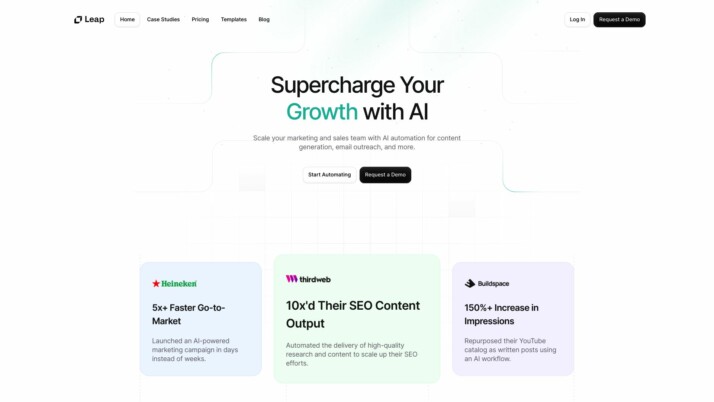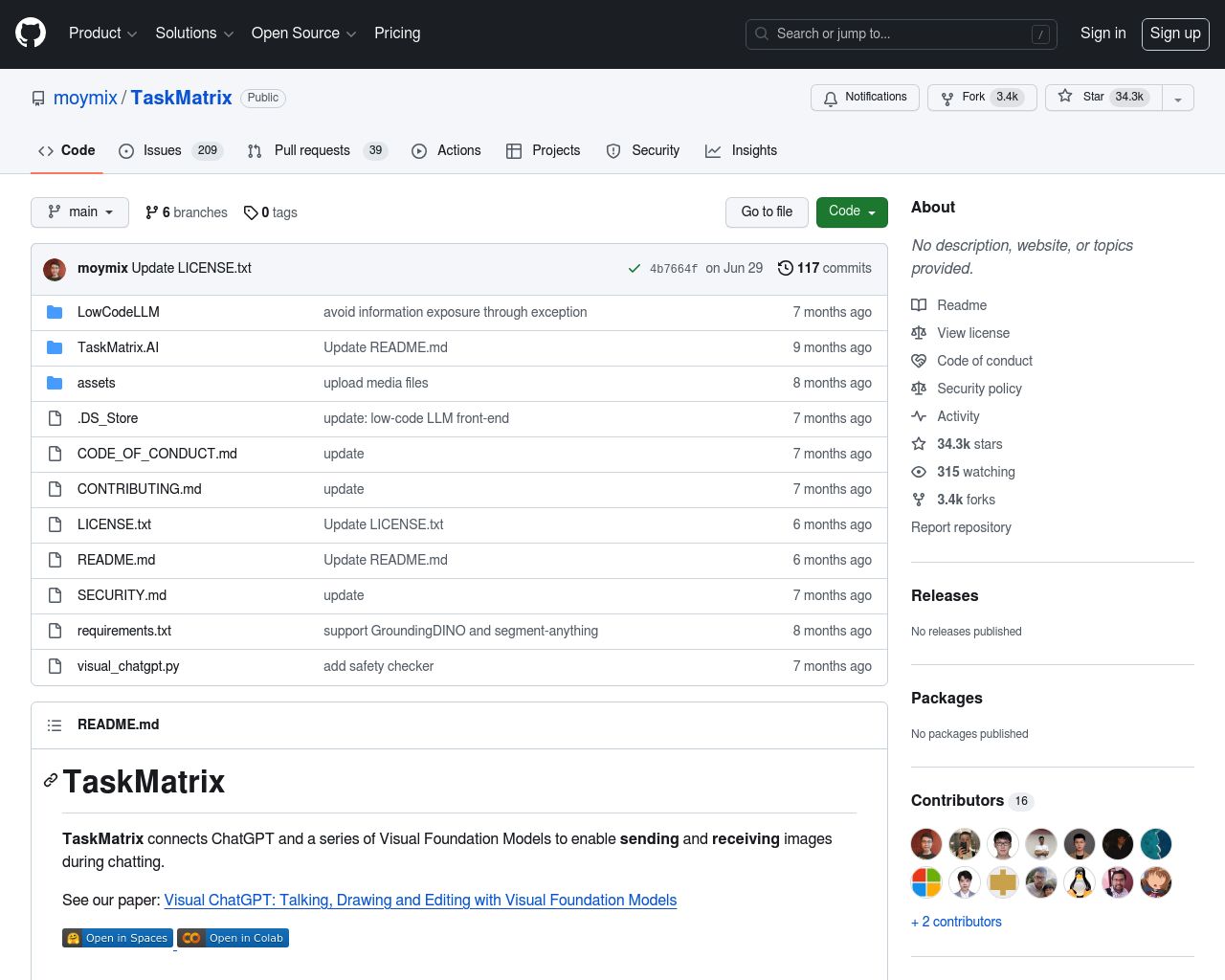Leap AI vs. TaskMatrix: Comparing AI Agent Platforms
AI agent platforms are transforming the way businesses harness artificial intelligence, offering powerful tools to streamline operations and drive innovation. This review compares three leading solutions: Leap AI vs. TaskMatrix, and SmythOS. We’ll explore their unique features, ease of use, and suitability for different user groups, from developers to non-technical professionals. By examining each platform’s strengths and limitations, we aim to help you identify the best fit for your AI development needs, whether you’re building complex workflows, integrating multiple APIs, or seeking a user-friendly solution for AI-powered applications.
Leap AI Overview
Leap AI empowers users to create sophisticated AI workflows without coding expertise. The platform’s drag-and-drop interface and comprehensive SDK support enable rapid development of AI-powered applications across various domains. Leap AI integrates seamlessly with popular tools like Slack, HubSpot, and Zapier, expanding its utility for businesses of all sizes.
The heart of Leap AI lies in its extensive template library and support for diverse AI models. Users can leverage pre-built templates to quickly generate blog posts, create music, or summarize leads. The platform’s flexibility shines through its compatibility with models like OpenAI GPT, Mistral 7b, and Stable Diffusion XL, catering to a wide array of AI tasks from text generation to image creation.
Leap AI’s user-friendly dashboard serves as a central hub for creating, managing, and executing AI workflows. The visual editor simplifies the design process, allowing users to construct complex AI-driven processes without delving into code. This accessibility democratizes AI technology, enabling businesses to harness its power for automating tasks, improving efficiency, and fostering innovation.


Screenshot of Leap AI Website
Leap AI’s user-friendly dashboard serves as a central hub for creating, managing, and executing AI workflows. The visual editor simplifies the design process, allowing users to construct complex AI-driven processes without delving into code.
Leap AI extends its capabilities beyond simple automation. The platform offers tools for training and fine-tuning custom AI models, allowing users to tailor AI outputs to their specific needs. This feature enhances the accuracy and relevance of AI-generated content, making it invaluable for businesses seeking to maintain brand consistency or address unique industry challenges.
While Leap AI excels in many areas, it’s important to note that some advanced features like autonomous agents, explainability tools, and debug modes are not explicitly mentioned in their offerings. Additionally, the platform’s focus on no-code solutions may limit customization options for users with more specific or complex requirements. Despite these considerations, Leap AI stands out as a powerful tool for businesses and individuals looking to leverage AI technology without extensive technical expertise.
TaskMatrix Overview
TaskMatrix connects powerful foundation models with specialized APIs, enabling AI agents to perform a wide range of digital and physical tasks. Developed by Microsoft, this open-source platform enhances the capabilities of models like GPT-4 by integrating them with task-specific APIs.
TaskMatrix functions as an AI project manager, bridging diverse models to execute complex operations efficiently. Its core components include a conversational foundation model for understanding user inputs, a comprehensive API platform, an intelligent API selector, and an action executor. This architecture allows TaskMatrix to interpret instructions, generate executable code, and carry out tasks using the most appropriate APIs.
TaskMatrix functions as an AI project manager, bridging diverse models to execute complex operations efficiently.
The platform excels in its versatility, supporting both digital and physical task execution. It offers lifelong learning capabilities, allowing AI agents to continuously improve their performance. TaskMatrix provides interpretable responses, making it easier for users to understand the logic behind task solutions and API outcomes.


While TaskMatrix offers powerful capabilities, it requires technical expertise to implement effectively. The platform’s open-source nature means users must manage their own hosting and infrastructure. Additionally, TaskMatrix lacks some features found in commercial platforms, such as a visual builder or no-code editor, which may limit its accessibility for non-technical users.
TaskMatrix’s strength lies in its ability to connect AI models with a vast array of APIs, enabling complex task execution across various domains. This makes it particularly valuable for developers and organizations looking to build advanced AI systems that can handle diverse, multi-step operations. However, its technical nature may pose challenges for those seeking an out-of-the-box solution for AI agent deployment.
Feature Comparison
SmythOS and TaskMatrix offer distinct approaches to AI agent development, with key differences in their core components and security features. SmythOS provides a comprehensive hosted solution with both development and production environments, while TaskMatrix requires self-hosting. This gives SmythOS an edge in ease of deployment and management.
In terms of core components, SmythOS excels with its visual builder and no-code editor, making AI development accessible to users without extensive coding knowledge. TaskMatrix, while powerful, lacks these user-friendly features, potentially limiting its audience to more technical users. SmythOS also offers robust debug tools and explainability features, enhancing transparency and aiding in troubleshooting — capabilities not explicitly mentioned for TaskMatrix.
Security-wise, SmythOS implements strong measures including data encryption, OAuth integration, and IP control. TaskMatrix’s open-source nature allows for customizable security, but requires more hands-on configuration. SmythOS’s built-in security features provide a more turnkey solution for enterprise-grade protection.
While both platforms support integration with various AI models and APIs, SmythOS offers a wider range of deployment options, including as APIs, webhooks, and scheduled agents. TaskMatrix’s flexibility comes from its open-source nature, but may require more effort to achieve similar deployment versatility.
SmythOS’s hosted vector database and support for various data formats (PDF, Word, TXT) give it an advantage in data handling capabilities. TaskMatrix’s data management features are less clearly defined in the available information.
Overall, SmythOS emerges as a more comprehensive, user-friendly solution with robust security and deployment options, while TaskMatrix offers flexibility through its open-source model but may require more technical expertise to fully leverage its capabilities.
Feature Comparison Table
| Leap AI | TaskMatrix | SmythOS | |
|---|---|---|---|
| CORE FEATURES | |||
| Hosted Agents (Dev, Production) | ❌ | ✅ | ✅ |
| Autonomous Agents | ❌ | ✅ | ✅ |
| Explainability & Transparency | ❌ | ✅ | ✅ |
| Debug Tools | ❌ | ✅ | ✅ |
| Multi-Agent Collaboration | ❌ | ✅ | ✅ |
| SECURITY | |||
| Constrained Alignment | ❌ | ✅ | ✅ |
| COMPONENTS | |||
| Data Lakes | ❌ | ❌ | ✅ |
| DEPLOYMENT OPTIONS (EMBODIMENTS) | |||
| DATA LAKE SUPPORT | |||
| Hosted Vector Database | ❌ | ❌ | ✅ |
| Sitemap Crawler | ✅ | ❌ | ✅ |
| YouTube Transcript Crawler | ✅ | ❌ | ✅ |
Best Alternative to Leap AI and TaskMatrix
SmythOS stands out as the superior alternative to Leap AI and TaskMatrix, offering a comprehensive AI automation platform that combines power with ease of use. Our platform revolutionizes the creation and deployment of AI agents, making advanced AI capabilities accessible to users across various technical backgrounds.
Unlike Leap AI and TaskMatrix, SmythOS provides a unique blend of visual programming and extensive customization options. Our intuitive drag-and-drop interface allows users to design complex AI workflows without extensive coding knowledge, significantly reducing development time and expanding AI accessibility. This feature sets SmythOS apart, enabling rapid prototyping and deployment of AI solutions that would otherwise require substantial technical expertise.
SmythOS provides a unique blend of visual programming and extensive customization options. Our intuitive drag-and-drop interface allows users to design complex AI workflows without extensive coding knowledge…
SmythOS excels in its robust integration ecosystem, surpassing both Leap AI and TaskMatrix. We offer seamless connections to a vast array of external services, APIs, and AI models, including those from OpenAI, Anthropic, and Hugging Face. This flexibility ensures that SmythOS can adapt to virtually any business process or workflow, providing a level of versatility unmatched by our competitors.
In terms of scalability and deployment options, SmythOS offers unparalleled capabilities. Our platform supports multi-agent systems, allowing for sophisticated collaboration between AI agents to tackle complex tasks. We provide diverse deployment options, including as APIs, webhooks, scheduled agents, and even ChatGPT plugins, ensuring that our AI solutions can be integrated seamlessly into existing systems. This range of options far exceeds what Leap AI and TaskMatrix offer, making SmythOS the ideal choice for businesses looking to implement AI at scale.
SmythOS offers unparalleled capabilities. Our platform supports multi-agent systems, allowing for sophisticated collaboration between AI agents to tackle complex tasks.
Security and transparency are paramount in AI development, and SmythOS leads the way in these critical areas. We implement robust security measures, including data encryption and OAuth integration, providing enterprise-grade protection for sensitive information. Our platform also offers advanced debugging and monitoring tools, ensuring full transparency in AI operations. These features give SmythOS a significant edge over Leap AI and TaskMatrix, particularly for organizations prioritizing data security and AI explainability.
Conclusion
Leap AI, TaskMatrix, and SmythOS each offer unique approaches to AI agent development and deployment. Leap AI shines with its user-friendly interface and extensive template library, making it accessible for non-technical users. TaskMatrix, as an open-source solution from Microsoft, provides powerful capabilities for connecting AI models with specialized APIs, appealing to developers seeking flexibility and customization.
However, SmythOS emerges as the superior choice, combining ease of use with advanced features and enterprise-grade security. Our drag-and-drop interface and no-code editor democratize AI development, while our comprehensive integration ecosystem supports over 300,000 connections. SmythOS’s multi-agent collaboration, debug tools, and explainability features ensure transparency and efficiency in complex AI workflows.
Unlike its competitors, SmythOS offers unparalleled deployment flexibility. Our “Create Once, Deploy Anywhere” approach allows seamless integration across multiple platforms, from APIs and webhooks to chatbots and scheduled agents. This versatility, combined with our robust security measures and scalable architecture, makes SmythOS ideal for businesses of all sizes seeking to leverage AI for innovation and growth.
To experience the full potential of AI agent development and deployment, create a free SmythOS account today. Explore our extensive template library to jumpstart your projects, and discover how our comprehensive documentation can guide you through building powerful, customized AI solutions. With SmythOS, you’re not just adopting an AI platform; you’re unlocking a new era of efficiency and innovation for your business.
Last updated:
Disclaimer: The information presented in this article is for general informational purposes only and is provided as is. While we strive to keep the content up-to-date and accurate, we make no representations or warranties of any kind, express or implied, about the completeness, accuracy, reliability, suitability, or availability of the information contained in this article.
Any reliance you place on such information is strictly at your own risk. We reserve the right to make additions, deletions, or modifications to the contents of this article at any time without prior notice.
In no event will we be liable for any loss or damage including without limitation, indirect or consequential loss or damage, or any loss or damage whatsoever arising from loss of data, profits, or any other loss not specified herein arising out of, or in connection with, the use of this article.
Despite our best efforts, this article may contain oversights, errors, or omissions. If you notice any inaccuracies or have concerns about the content, please report them through our content feedback form. Your input helps us maintain the quality and reliability of our information.
